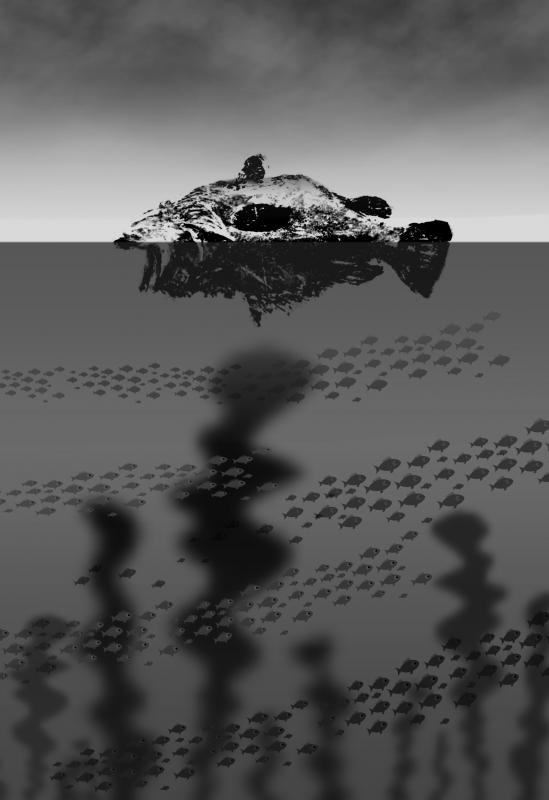Heating of the world’s oceans could radically reorganize marine food webs across the globe, causing the numbers of some species to collapse while promoting the growth of algae, new research has warned.
Healthy marine food webs that look like a pyramid, with smaller numbers of larger predatory species at the top and more abundant smaller organisms at the bottom, could become “bottom heavy.”
The types of species that could become less abundant in the oceans are the same ones targeted by commercial fishing and also are socially and culturally important to many communities around the globe.

Illustration: Yusha
In the research, published in the journal Science, researchers at the University of Adelaide recreated a marine habitat in a series of 1,800-liter tanks and then subjected some to temperature and carbon dioxide changes.
Ivan Nagelkerken, a professor in the university’s Environment Institute who led the research, said gazing into the tanks after six months when the study period ended had not been a pretty sight.
“It looked bad,” he said.
After being subjected to higher temperatures and higher carbon dioxide, the rocks were overgrown with turf algae and the sandy bottom had a lot more slimy algae that is toxic to some species, he said.
The tanks recreated a habitat off the coast of Adelaide in Gulf St Vincent that was about 6m deep.
Many of the species placed into the tanks — including kelp, crustaceans and the multitude of different bacteria on rocks, sand and in sediment — were gathered from the gulf. Native fish and crabs were also added.
Twelve tanks of ocean water — known as mesocosms — were split into four groups. Temperature and carbon dioxide levels were not adjusted in one group.
In another four tanks, the water temperature was raised over the course of six weeks until they were 2.8oC higher than today.
Another group of tanks had their carbon dioxide levels adjusted to the equivalent of 910 parts per million in the atmosphere, causing the water to become less alkaline.
The habitat in the fourth group of tanks was treated to both higher temperatures and higher levels of carbon dioxide.
Both the carbon dioxide conditions and the temperatures reflect conditions expected towards the end of this century in a world where little is done to curb fossil fuel burning.
Nagelkerken said the results of the experiment remained relevant even if the world did act to slow down the rising levels of carbon dioxide in the atmosphere.
In 2011 a marine heatwave in Western Australia raised ocean temperatures more than 2oC for about 10 weeks. A study five years later found no recovery of the kelp — a vital component shaping the marine ecosystem there.
“That marine heatwave showed that even over just a few weeks, that caused the kelp to disappear,” Nagelkerken said.
He said the research showed that ocean heating “reshuffles species communities” with weedy plants and algae thriving, but the “abundance of other species, especially invertebrates, collapses.”
Nagelkerken said the changed pyramid that was fatter at the bottom and thinner in the middle, could eventually see larger predators also losing out.
In the study, the researchers write: “The top of food webs may eventually become depleted under future climate conditions or additional human disturbances.”
The small fish that were the predators in the tank resisted the impacts of warming, but the experiment showed the food they ate was becoming impoverished — an imbalance that could see the top predators struggling.
An ecological tipping point could be reached where “the top of the food web can no longer be supported,” the study says.
Nagelkerken said that in the real world, the impacts would vary depending on whether species could move to different areas. Some species would not be able to.
He said there was already evidence species were extending their ranges away from the equator as oceans got warmer and this, together with changes to the food webs, could also see traditional fishing grounds move, creating knock-on effects for communities that had been built around fishing.
“It’s not just climate change, but also our removal of predatory fish [through overfishing] and the addition of nutrients into the ocean. We have to consider all of that too,” he added.
Kirsty Nash, of the Institute for Marine and Antarctic Studies at the University of Tasmania, who was not involved in the research, said studying the resilience of marine systems was challenging, and the researchers had struck a balance between what was practically possible while giving an insight into real-world impacts.
“Developing this type of understanding is really important if we want to then address questions around the broader consequences of climate change for society, for example, are fisheries likely to suffer as a result of climate change,” she said.
The experimental findings in the tanks were likely only showing an “intermediate state” that was a prelude to the development of “radically different” food webs, she said.
She said many places in the world had fish that societies consumed, but that the study suggested would be impacted.
“These local fish are popular eating fish, so this would have implications for what’s available, but it does depend on the area and how culturally and socially acceptable that would be,” she said.
Sophie Dove, an associate professor at the University of Queensland, who has run large long-term mesocosm experiments, said the study adds to mounting evidence that under the current trajectory of carbon dioxide emissions “services will be lost from our most valued ecosystems.”
She said she would have preferred that the experimental conditions had more closely mirrored the daily and seasonal changes in light, temperature and carbon dioxide.
However, the experiment demonstrated that organisms at the bottom of the food chain — such as “relatively inedible slimy algae” — did well under the changing conditions, but small plants that helped give rocky reefs their structure “do very badly under warming and acidification,” she said.

In the past month, two important developments are poised to equip Taiwan with expanded capabilities to play foreign policy offense in an age where Taiwan’s diplomatic space is seriously constricted by a hegemonic Beijing. Taiwan Foreign Minister Lin Chia-lung (林佳龍) led a delegation of Taiwan and US companies to the Philippines to promote trilateral economic cooperation between the three countries. Additionally, in the past two weeks, Taiwan has placed chip export controls on South Africa in an escalating standoff over the placing of its diplomatic mission in Pretoria, causing the South Africans to pause and ask for consultations to resolve
An altercation involving a 73-year-old woman and a younger person broke out on a Taipei MRT train last week, with videos of the incident going viral online, sparking wide discussions about the controversial priority seats and social norms. In the video, the elderly woman, surnamed Tseng (曾), approached a passenger in a priority seat and demanded that she get up, and after she refused, she swung her bag, hitting her on the knees and calves several times. In return, the commuter asked a nearby passenger to hold her bag, stood up and kicked Tseng, causing her to fall backward and
In South Korea, the medical cosmetic industry is fiercely competitive and prices are low, attracting beauty enthusiasts from Taiwan. However, basic medical risks are often overlooked. While sharing a meal with friends recently, I heard one mention that his daughter would be going to South Korea for a cosmetic skincare procedure. I felt a twinge of unease at the time, but seeing as it was just a casual conversation among friends, I simply reminded him to prioritize safety. I never thought that, not long after, I would actually encounter a patient in my clinic with a similar situation. She had
The election campaign for the Chinese Nationalist Party (KMT) chair is heating up, with only 10 days left before party members cast their ballots on Oct. 18. The campaign has revealed potential strengths for the party going into important elections next year and in 2028, particularly the desire among leading candidates to deepen cooperation with the Taiwan People’s Party (TPP). However, it has also exposed the party’s persistent weaknesses, especially in formulating a policy on cross-strait relations that can appeal to the majority of Taiwanese. Six candidates are registered: former Taipei mayor Hau Lung-bin (郝龍斌), 73; former legislator Cheng Li-wun